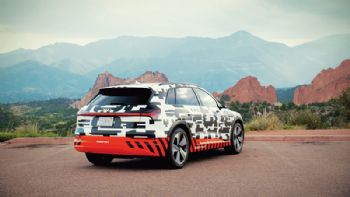
The Audi e-tron prototype — a full-size SUV combining power and high efficiency — has a fully electric drive system rated at 300kW that allows it to accelerate from 0 to 62mph in less than 6sec.
Moreover, in the new WLTP test cycle, the vehicle can cover more than 248 miles on one battery charge.
Contributing to its range is the power recuperation system, which was demonstrated at the recent Pikes Peak hill climb in the southern Rocky Mountains.
Standing 14,115ft high, Pikes Peak was where Walter Röhrl won the world-famous hill climb in an Audi Sport Quattro S1 in 1987; this year, Audi hit the headlines with its e-tron.
On its 19-mile descent after racing up the mountain, the e-tron (
www.audi.com) prototype fed enough energy back to the battery for it to cover almost the same distance again (the 6,233.6ft difference in altitude provided the necessary conditions for this).
The recuperation system, which contributes up to 30% of the electric SUV’s range, involves both of the SUV’s electric motors and the electro-hydraulically integrated brake control system.
Three different recuperation modes are combined: manual coasting recuperation, automatic coasting recuperation via the predictive efficiency assist, and brake recuperation with smooth transition between electric and hydraulic deceleration.
At deceleration rates up to 0.3g, the Audi e-tron prototype recuperates energy solely via the electric motors, without using the conventional brake (this mode covers over 90% of all decelerations).
As a result, energy is fed back to the battery in practically all normal ‘braking’ manoeuvres.
The driver can select the degree of coasting recuperation in three stages, using the steering-wheel paddles.
At the lowest stage, the vehicle coasts with no additional drag torque when the driver releases the accelerator pedal.
At the highest stage, the electric SUV reduces speed noticeably, with the driver slowing down and accelerating using only the accelerator pedal (there is no need to use the brake pedal in this deceleration scenario).
The wheel brakes are involved only when the driver decelerates by more than 0.3g using the brake pedal.
Depending on the driving situation, the electro-hydraulically integrated brake control system decides whether the e-tron prototype will decelerate using the electric motor, the wheel brake or a combination of the two.
The brake pedal is decoupled from the hydraulic system (the transition from the engine brake to the pure friction brake is smooth, and the driver does not notice it).